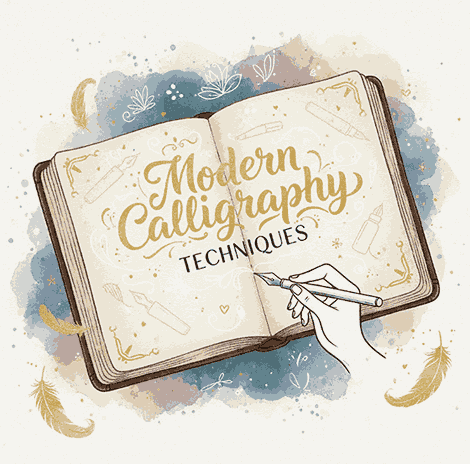Table of Contents
- Introduction
- What Is Modern Calligraphy?
- How Modern Calligraphy Differs from Traditional Styles
- Essential Tools for Modern Calligraphy
- Core Techniques to Master
- Common Mistakes Beginners Should Avoid
- Digital Calligraphy: Blending Tradition and Technology
- Inspiring Modern Calligraphy Font Examples
- Tips to Improve Your Calligraphy Skills
- Conclusion
- References
1. Introduction
Modern Calligraphy Techniques has evolved from ancient scripts into a modern art form embraced by designers, artists, and lettering enthusiasts worldwide. With the rise of digital design, modern calligraphy techniques now blend timeless craftsmanship with the convenience of technology.
Whether you’re a beginner exploring brush strokes or a designer seeking inspiration for your next project, this guide will help you understand the beauty and business of modern calligraphy — from techniques and tools to digital fonts you can use today.

2. What Is Modern Calligraphy Techniques?
Modern calligraphy is an expressive, free-form style of writing that draws inspiration from classic calligraphy but allows for personal flair and experimentation.
Unlike traditional scripts (such as Copperplate or Spencerian), modern calligraphy gives you creative freedom — you can play with letter spacing, thickness, and flow.
It’s not just a writing technique; it’s a visual art form used in wedding invitations, brand logos, home décor, and digital font creation.
3. How Modern Calligraphy Techniques Differs from Traditional Styles
While traditional calligraphy follows precise rules of structure and proportion, modern calligraphy focuses on expression and emotion.
Here’s how they differ:
| Aspect | Traditional Calligraphy | Modern Calligraphy |
|---|---|---|
| Structure | Strict, formal | Free-form, expressive |
| Tools | Dip pens, nibs, ink | Brush pens, digital stylus |
| Purpose | Historical scripts | Personal style and modern design |
| Medium | Paper | Paper & digital platforms |
This flexibility makes modern calligraphy perfect for today’s digital artists and type designers who want to merge classic beauty with contemporary trends.
4. Essential Tools for Modern Calligraphy Techniques
Getting started doesn’t require expensive equipment — just the right tools and practice.
Here are essentials every calligrapher needs:
- Brush Pens: Flexible tips for thick and thin lines.
- Pointed Pen & Nib: Great for traditional-to-modern transition styles.
- Smooth Paper: Prevents ink bleeding and improves flow.
- Ink & Watercolors: For expressive, colorful lettering.
- Digital Tools: iPad + Apple Pencil + Procreate for digital calligraphy practice.
Digital tools have revolutionized calligraphy — allowing you to create and refine letterforms seamlessly.
5. Core Techniques to Master
Here are key modern calligraphy techniques to build your foundation:
- Pressure Control: Apply pressure on downstrokes for thick lines; release pressure on upstrokes for thin lines.
- Letter Connections: Keep spacing consistent to create natural flow between letters.
- Consistency: Focus on balance and rhythm rather than perfection.
- Angle Practice: Experiment with different pen angles for unique textures.
- Flourishing: Add decorative swirls and loops to enhance elegance.
Mastering these basics will make your lettering more expressive and visually appealing.

6. Common Mistakes Beginners Should Avoid
Even experienced designers make mistakes when adapting to calligraphy. Here’s what to avoid:
- Pressing too hard on every stroke
- Ignoring consistent spacing
- Rushing through practice sessions
- Using low-quality paper or pens
- Comparing your work to others
Remember: calligraphy is about progress, not perfection. Each letter tells your creative story.
7. Digital Calligraphy: Blending Tradition and Technology
Modern calligraphy isn’t limited to paper anymore.
Thanks to design software like Procreate, Adobe Illustrator, and Affinity Designer, you can now digitize your lettering to create logos, social media content, and custom fonts.
This digital transformation allows calligraphers to:
- Refine their lettering with precise vector editing.
- Create scalable calligraphy fonts for branding.
- Sell digital products like calligraphy fonts on sites like EdricStudio
For example, many of Edric Studio’s most popular fonts are inspired by modern calligraphy principles.
8. Inspiring Modern Calligraphy Techniques Font Examples
Here are some beautiful calligraphy font mockups from Edric Studio that reflect different modern calligraphy techniques:
- Straight White Calligraphy Font – A soft and flowing script with elegant curves, perfect for invitations and branding.
- Wedding Dream Calligraphy Font – A romantic script font that captures the essence of modern wedding stationery.
- Xenia Urshina Calligraphy Font – A chic and sophisticated modern calligraphy font with graceful movement.
These fonts demonstrate how artistic lettering can transform into profitable design assets — ideal for designers looking to make money creating calligraphy fonts.
9. Tips to Improve Your Calligraphy Skills
- Practice Daily: Even 15 minutes a day builds consistency.
- Study Letter Anatomy: Understand how strokes connect to form cohesive words.
- Use Guidelines: Keep your baseline steady for balanced lettering.
- Experiment with Tools: Try different brushes, nibs, and apps.
- Create Your Own Fonts: Turn your hand lettering into digital typefaces.
By combining discipline with creativity, you can turn your calligraphy passion into both art and income.
10. Conclusion
Modern calligraphy is more than an artistic hobby — it’s a timeless skill reimagined for the digital world.
By learning the right modern calligraphy techniques, using high-quality tools, and practicing regularly, you can express yourself beautifully through letterforms and even build a creative business from it.
Whether you’re designing by hand or digitally crafting typefaces for sale, let your lettering tell your story — elegant, modern, and uniquely yours.
Explore inspiring fonts at EdricStudio and discover how modern calligraphy continues to shape the design world.
11. References
- Just The Skills — Calligraphy vs Hand Lettering
- Vial Designs — Modern Calligraphy 101 for Beginners
- Loveleigh Loops — Modern Calligraphy for Beginners
- The Happy Ever Crafter — Calligraphy vs Hand Lettering vs Fonts

